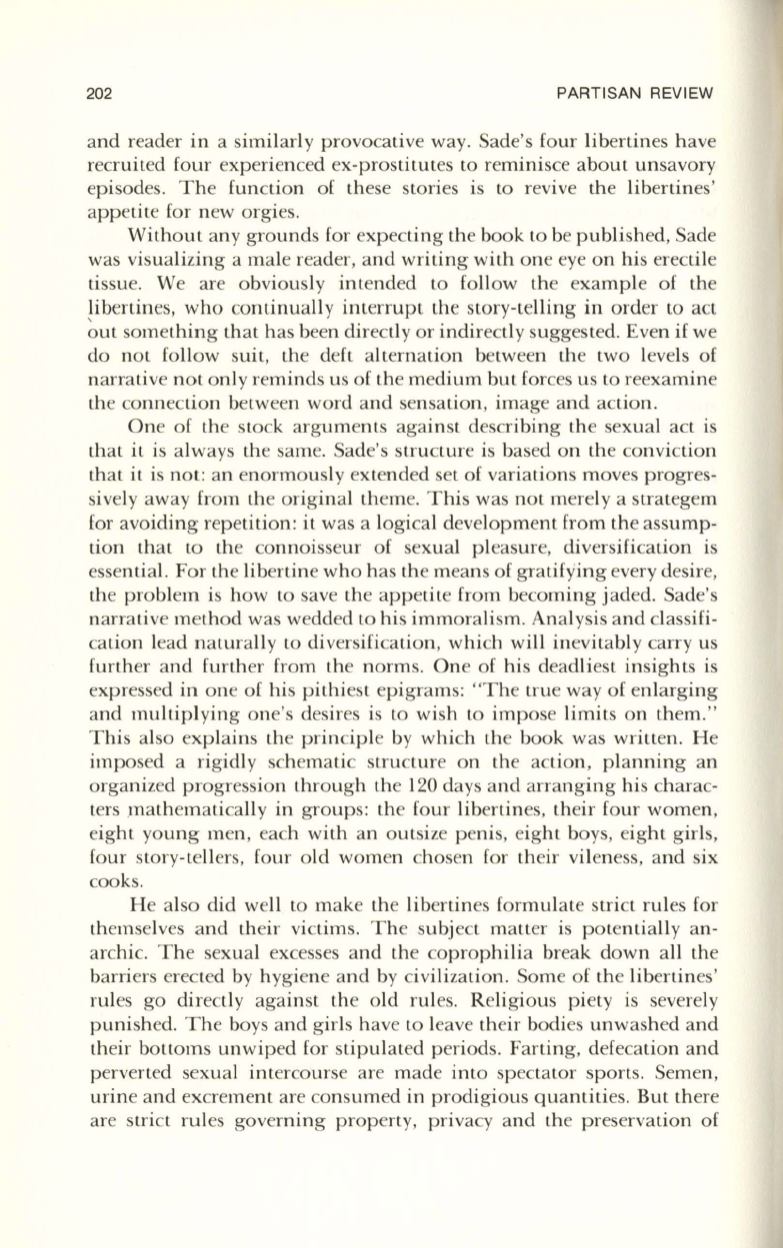
202
PARTISAN REVIEW
and reader in a similarly provocative way. Sade's four libertines have
recruited four experienced ex-prostitutes to reminisce about unsavory
episodes. The function of these stories is to revive the libertines'
appetite for new orgies.
Without any grounds for expecting the book to be published, Sade
was visualizing a male reader, and writing with one eye on his erectile
tissue. We are obviously intended to follow the example of the
libertines, who continually interrupt the story-telling in order to act
~ut
something that has been directly or indirectly suggested. Even if we
do not follow suit, the deft alternation between the two levels of
narrative not only reminds us of the medium but forces us to reexamine
the connection between word and sensation, image and action.
One of the stock arguments against describing the sexual act is
that it is always the same. Sade's structure is based on the conviction
that it is not: an enormously extended set of variations moves progres–
sively away from the original theme. This was not merely a strategem
for avoiding repetition: it was a logical development from the assump–
tion that to the connoisseur of sexual pleasure, diversification is
essential. For the libertine who has the means of gratifying every desire,
the problem is how to save the appetite from becoming jaded. Sade's
narrative method was wedded to his immoral ism. Analysis and classifi–
cation lead naturally to diversification, which will inevitably carry us
further and further from the norms. One of his deadliest insights is
expressed in one of his pithiest epigrams: "The true way of enlarging
and multiplying one's desires is to wish to impose limits on them."
This also explains the principle by which the book was written. He
imposed a rigidly schematic structure on the action, planning an
organized progression through the 120 days and arranging his charac–
ters .mathematically in groups: the four libertines, their four women,
eight young men, each with an outsize penis, eight boys, eight girls,
four story-tellers, four old women chosen for their vileness, and six
cooks.
He also did well to make the libertines formulate strict rules for
themselves and their victims. The subject matter is potentially an–
archic. The sexual excesses and the coprophilia break down all the
barriers erected by hygiene and by civilization. Some of the libertines'
rules go directly against the old rules. Religious piety is severely
punished. The boys and girls have to leave their bodies unwashed and
their boltoms unwiped for stipulated periods. Farting, defecation and
perverted sexual intercourse are made into spectator sports. Semen,
urine and excrement are consumed in prodigious quantities. But there
are strict rules governing property, privacy and the preservation of


